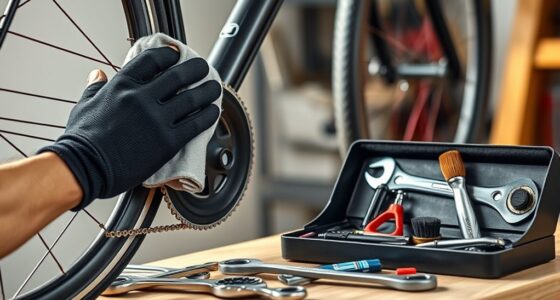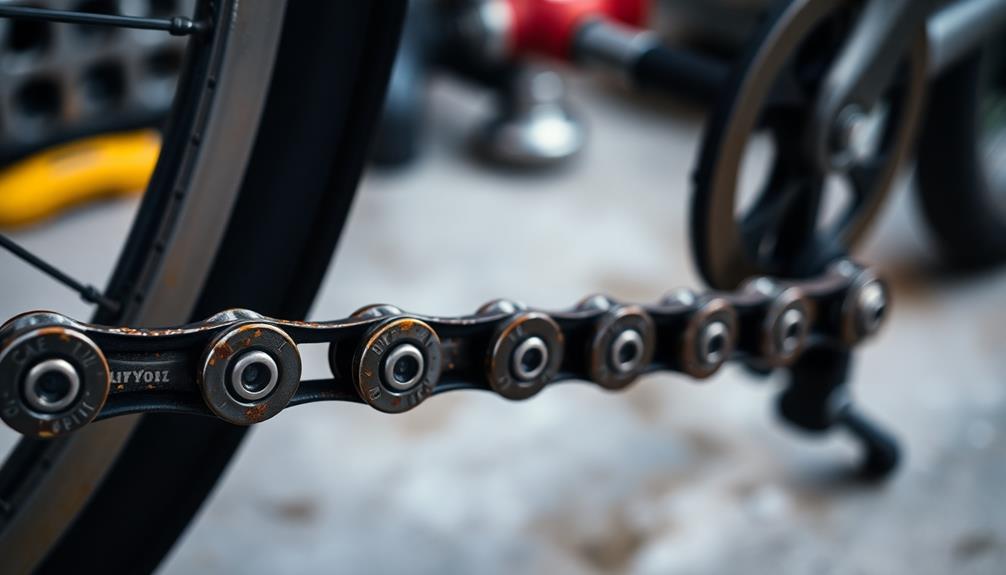To prevent saddle sores during long rides, guarantee your bike fits well, use padded, moisture-wicking shorts, and apply chamois cream beforehand. Shift your position regularly, stand up briefly, and keep the area dry and clean after riding. If sores develop, treat them promptly with antibacterials, avoid popping them, and maintain good hygiene. Continuing to learn effective techniques will help you enjoy rides comfortably and stay protected from persistent issues.
Key Takeaways
- Apply chamois cream before rides and change into moisture-wicking shorts immediately afterward to reduce friction and moisture buildup.
- Ensure proper bike fit by adjusting saddle height, tilt, and position to distribute pressure evenly and minimize irritation.
- Take frequent breaks, shift weight regularly, and stand up briefly during long rides to improve circulation and reduce pressure points.
- Maintain hygiene by showering promptly, keeping the area dry, and using antibacterial or antimicrobial ointments to prevent infection.
- Recognize early signs of soreness or infection and seek professional help for persistent or severe saddle sores.
Understanding the Causes of Saddle Soreness
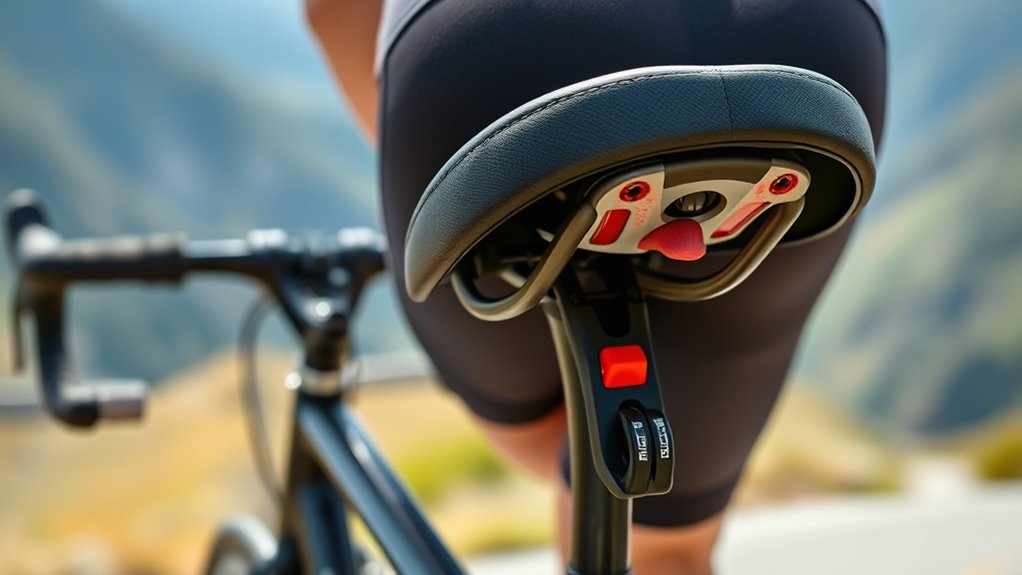
Saddle soreness primarily results from friction, pressure, and moisture buildup in areas like your sit bones and perineum during cycling. These factors irritate your skin, causing saddle sores. Friction occurs as your body constantly moves against the saddle, damaging the outer skin layer. Excessive pressure from prolonged rides compresses tissues, increasing the risk of skin breakdown. Moisture from sweat creates a damp environment that worsens friction and encourages bacterial growth. When your clothing traps sweat and heat, it heightens irritation and the chance of developing sores. Repeated exposure to these conditions can lead to open wounds, blisters, or infected hair follicles. Understanding these causes helps you take better precautions, like reducing friction and managing moisture, to prevent saddle soreness and keep your rides comfortable.
Ensuring Proper Bike Fit for Comfort

Getting your bike properly fitted is essential for comfort and preventing saddle sores. A professional bike fit optimizes saddle height, handlebar position, and overall geometry, reducing pressure points. Proper fit ensures even weight distribution across your sit bones, minimizing friction and skin irritation. Adjusting saddle tilt and fore-aft position alleviates pressure on sensitive areas, preventing saddle sores. Correct sizing also prevents hip and leg misalignments that cause discomfort. Regularly reassess your bike fit, especially after flexibility changes or longer rides, to maintain comfort and saddle sore prevention.
| Fit Aspect | Benefit |
|---|---|
| Saddle height | Reduces pressure and improves pedaling efficiency |
| Handlebar position | Enhances comfort and reduces strain |
| Saddle tilt | Prevents localized friction and sores |
| Fore-aft adjustment | Optimizes pressure distribution |
| Overall geometry | Prevents misalignments and discomfort |
Selecting the Right Saddle and Clothing
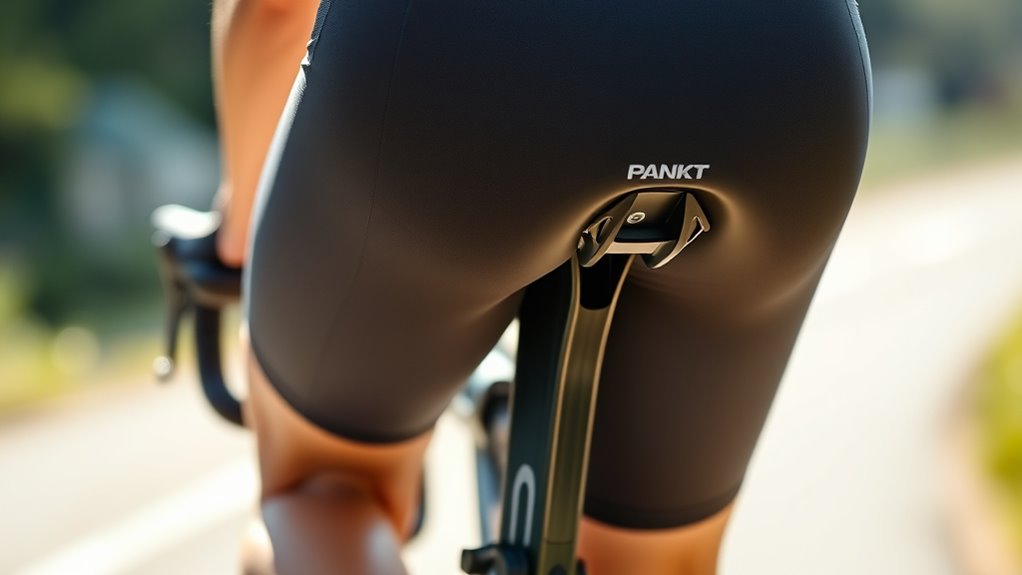
How do you choose the right saddle and clothing to prevent saddle sores? Start by selecting a saddle with an ergonomic shape, enough padding, and the correct width to minimize pressure points and chafing. Pair it with high-quality bike shorts that feature a well-designed chamois and moisture-wicking fabric to reduce friction and keep your skin dry. Opt for bib shorts instead of traditional underwear, as they stay in place and prevent bunching, which can cause irritation. Proper bike fit, including saddle height and fore-aft position, also plays a vital role in even pressure distribution. Finally, choose breathable, antimicrobial clothing materials and replace damp or dirty gear promptly after rides to prevent bacterial infections and skin irritation. Additionally, selecting a Dog breeds that is well-suited for outdoor activities can improve your riding experience and overall health.
Incorporating Preventative Habits and Routines
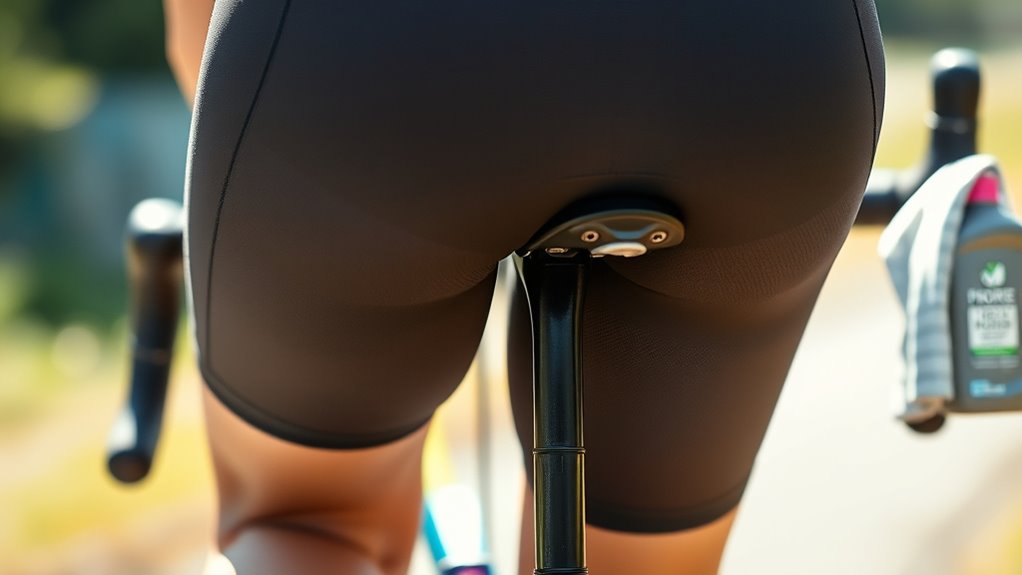
Implementing consistent preventative habits and routines can considerably reduce your risk of saddle sores. To protect your skin, start with these key steps:
- Apply chamois cream before each ride to create a protective barrier, reducing friction and preventing saddle sores.
- Change into clean, moisture-wicking cycling shorts immediately after riding to minimize moisture buildup and bacterial growth.
- Maintain good hygiene by washing the saddle area with antibacterial soap and drying thoroughly after every ride. Regular cleaning can also help remove product buildup that might contribute to irritation.
- Using essential oils such as tea tree oil with antimicrobial properties can help prevent infections and keep your skin healthy.
- Incorporating proper materials into your cycling wardrobe, such as moisture-wicking fabrics and well-fitted shorts, can further enhance comfort and skin protection.
- Understanding saddle sore causes and symptoms can help you identify early warning signs and take proactive steps to prevent more serious issues.
Recognizing Early Signs and Addressing Them

Pay close attention to early signs like redness, tenderness, or small bumps that appear after riding. If you notice discomfort, itching, or burning, it’s a warning to take action quickly. Addressing these symptoms right away with adjustments or creams can prevent more serious saddle sores. Utilizing AI-driven data analytics can help identify patterns and predict the likelihood of developing saddle sores, allowing for more proactive prevention. Being aware of environmental factors, such as humidity and temperature, can also influence the development of skin irritations and should be considered in your prevention strategy. Incorporating creative problem-solving techniques can further help identify effective solutions tailored to individual needs and conditions.
Early Symptom Indicators
Recognizing early signs of saddle sores is crucial for preventing more serious discomfort and skin damage. Being alert to initial indications can save you from painful sores later. Here are key early symptoms to watch for:
- Redness and skin irritation in the contact area, often appearing after a few hours of riding.
- Slight chafing or discomfort that signals the beginning of skin irritation.
- A tender bump or increased warmth and moisture, which can indicate inflammation or early infection.
- Increased awareness of data privacy concerns, as rider information and health data may be tracked or shared during cycling activities.
- Additionally, paying attention to skin hydration levels can help detect early dryness or tightness that might contribute to saddle irritation.
- Monitoring contact area health can help identify subtle changes before they develop into full sores.
- Proper saddle fit and adjusting riding position are essential in reducing friction and preventing irritation before symptoms appear.
If you notice these signs, take immediate action. Adjust your position, apply chamois cream, or take short breaks. Addressing early symptoms promptly helps prevent minor discomfort from escalating into full-blown saddle sores.
Prompt Treatment Strategies
When you notice early signs of saddle soreness, acting quickly can make all the difference in preventing more serious issues. Start by cleaning the area with antibacterial soap to reduce bacteria and prevent infection. Applying warm compresses can soothe tenderness and decrease inflammation. If you see small bumps or redness, use topical treatments like antibacterial or steroid creams to manage pain and control the sores. It’s important to distinguish minor irritation from infected sores; the latter may have pus, swelling, or increased redness. Addressing soreness promptly helps the sores heal naturally and minimizes the risk of needing invasive treatments or extended time off your bike. Good hygiene and early intervention are key to keeping saddle sores manageable and preventing setbacks on your ride. Additionally, using a proper saddle designed for comfort can help reduce the likelihood of developing sores during long rides. Incorporating air purifiers into your indoor environment can also support overall health and immune function, making your skin less vulnerable to infections. Recognizing the importance of environmental factors can further enhance your recovery and prevent future saddle soreness. Maintaining optimal air quality around your riding and living space can contribute significantly to skin health and overall recovery.
Effective Treatments for Saddle Sores

To treat saddle sores effectively, you should consider using topical medications like anti-chafing creams or petroleum jelly to protect and soothe the area. If a sore becomes severe or shows signs of infection, it’s important to know when to seek medical advice for drainage or antibiotics. Additionally, proper wound care, including keeping the area clean and avoiding squeezing sores, helps prevent complications and speeds healing. Regular outings and exposure to different environments can also reduce the likelihood of saddle sores by preventing skin irritation. Incorporating proper hygiene practices, such as gently cleansing the area after rides, can further support healing and prevent bacterial buildup. Exploring somatic therapy techniques may also help manage underlying stress or tension contributing to skin issues. Being mindful of piercing care and hygiene principles can further minimize irritation and aid recovery. Maintaining good skin health by staying hydrated and using gentle skincare products can also support healing and prevent further irritation.
Topical Medications and Creams
Topical medications and creams are essential tools in treating saddle sores effectively. They target infection, reduce inflammation, and ease pain, speeding up recovery. Here are key options to contemplate:
- Benzoyl peroxide: Apply this medicated cream twice daily to kill bacteria and promote skin peeling, which helps clear infected sores. Visible improvements may take several weeks.
- Medicated creams with anti-inflammatory properties: Hydrocortisone cream reduces swelling, itching, and discomfort, providing relief during healing.
- Topical anesthetics: Benzocaine ointments or sprays numb the area temporarily, decreasing pain and making rides more comfortable.
Using these creams consistently as part of your treatment plan can accelerate healing, prevent worsening, and reduce the risk of chronic saddle sores.
When to Drain Sores
If a saddle sore develops a visible head filled with pus, it can often be safely drain to speed up healing. Only drain infected sores with a clear white or yellow head to prevent worsening the infection. Proper drainage involves sterile techniques, such as cleaning the area with iodine and using a sterile needle or lancet. Avoid attempting to drain deep or unripe sores, as this can worsen the infection or cause complications. After draining, apply an antiseptic ointment like iodine or benzoyl peroxide to help prevent secondary bacterial infections. Remember, severe or persistent sores should be evaluated and drained by a healthcare professional to avoid complications. Knowing when to drain sores ensures proper treatment and faster recovery on your long ride.
Proper Wound Care
Proper wound care is essential for healing saddle sores effectively. To promote healing, keep the sores clean by washing the area with mild soap and thoroughly drying it. This prevents bacterial infection and speeds up recovery. You should also:
- Apply warm compresses for 10-15 minutes several times daily to reduce inflammation and encourage healing.
- Avoid picking or popping sores, as this can spread infection and worsen the condition.
- Use topical treatments like petroleum jelly or anti-chafing creams to create a protective barrier, reducing friction and irritation.
Best Practices During Rides to Minimize Soreness
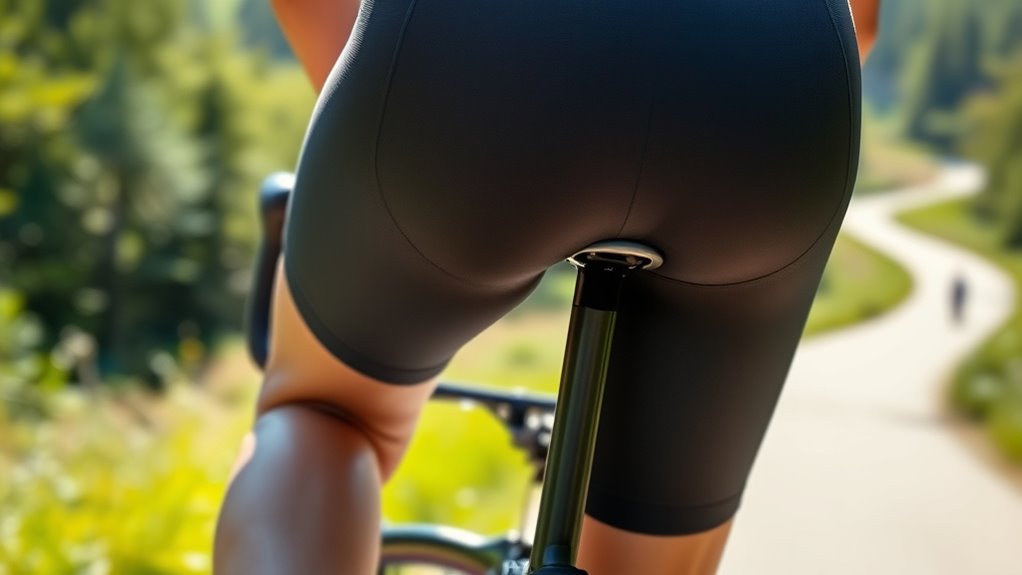
To minimize saddle soreness during your ride, it’s essential to regularly shift your weight and stand up briefly to relieve pressure on sensitive areas. Incorporate brief standing intervals, like 10 seconds every minute or 20 seconds every two minutes, to boost blood flow and reduce friction. Apply chamois cream before and during ride breaks to prevent saddle sore and keep it clean by wiping away sweat and moisture regularly. Using protective padding over hotspots can also reduce friction and discomfort. Remember, staying proactive during your ride can considerably lessen soreness. Here’s a quick guide to help:
| Action | Benefit | Tip |
|---|---|---|
| Shift weight frequently | Prevents pressure build-up | Every 1-2 minutes |
| Stand up briefly | Improves blood flow | 10-20 seconds intervals |
| Use chamois cream | Reduces chafing | Apply before and during ride |
| Keep it clean | Prevents bacterial buildup | Wipe sweat regularly |
| Add padding to hotspots | Minimizes friction | Use blister plasters or cushions |
Managing Persistent or Severe Sore Conditions
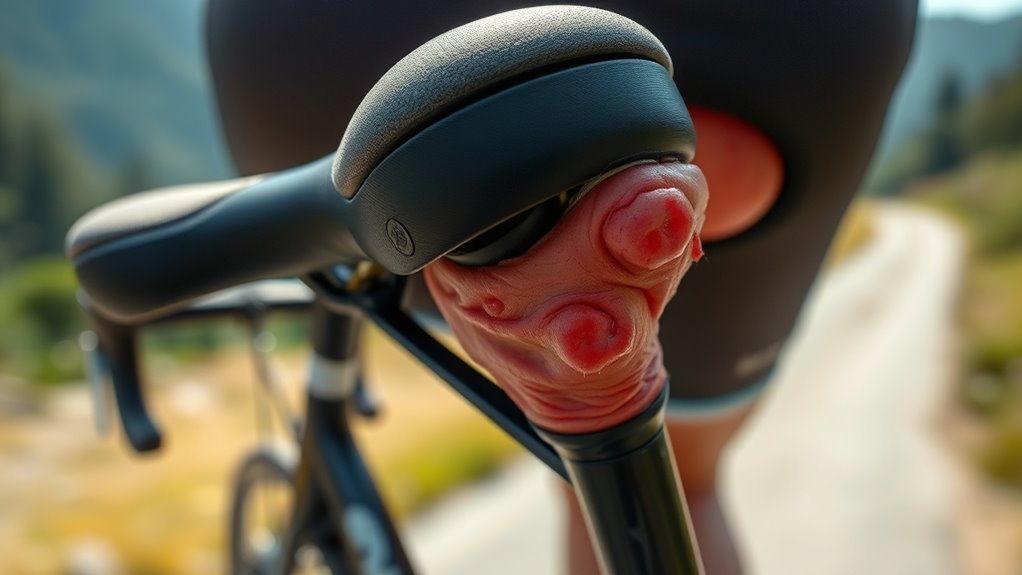
If your saddle sores persist or worsen over time, it’s essential to recognize when to seek medical help. Ignoring severe symptoms like increasing pain, redness, or pus can lead to infections or more serious complications. Developing a long-term care plan with proper treatment and rest can help speed recovery and prevent future issues.
When to Seek Medical Help
Persistent or severe saddle sores warrant prompt medical attention, especially if they continue to worsen despite home care. If your sores become increasingly painful, swollen, or produce pus, it’s time to see a healthcare professional. Additionally, seek medical help if you notice signs of infection, such as fever, spreading redness, warmth, or systemic symptoms. Don’t ignore sores that last more than two weeks without improvement, as they may indicate abscesses or other complications. If sores recur frequently or fail to heal, a doctor can evaluate for underlying issues like folliculitis. Remember, avoid self-draining or popping sores. Proper drainage and antibiotics are essential to prevent further infection, so consult a medical professional when in doubt.
Long-term Care Strategies
When saddle sores become long-lasting or severe, effective management is essential to prevent further complications. Long-term care focuses on promoting healing and preventing recurrence. Developing calluses through consistent riding and ensuring proper saddle fit can shield you from future saddle sores. Rest is essential; avoid riding on sore areas to allow natural healing and prevent worsening. If sores persist or worsen, seek medical evaluation—sometimes drainage or antibiotics are necessary. Maintaining excellent hygiene and applying topical medications like benzoyl peroxide can help manage recurrent or stubborn sores. Always watch for signs of infection, such as increased redness, swelling, or pain. Prompt medical attention can prevent complications like abscesses or the need for surgical intervention, supporting your long-term saddle sore management and recovery.
Long-Term Strategies for Saddle Soreness Prevention

Long-term prevention of saddle sores relies on consistent habits that promote skin resilience and proper cycling ergonomics. Building thickened skin or calluses helps distribute pressure during long rides, reducing soreness. You should regularly adjust your saddle position and choose well-fitted, high-quality cycling shorts to prevent friction and skin irritation. Incorporating frequent standing and position changes every 2-5 minutes during long rides minimizes sustained pressure and saddle sore risk. Additionally, gradually increasing your riding endurance allows your skin and tissues to adapt, making soreness less likely over time. To support prevention, maintain strict hygiene practices—shower promptly after rides and use antibacterial creams to prevent infections. These long-term strategies help you stay comfortable and avoid saddle sores during your cycling journey.
When to Seek Medical Advice and Professional Assistance

If saddle sores become increasingly painful, large, or show signs of infection like pus, spreading redness, warmth, or fever, it’s important to seek medical advice promptly. Ignoring these symptoms can lead to serious infections or abscesses. If sores don’t improve after two weeks of home care or recur frequently, consult a healthcare professional to identify underlying issues. Do not attempt to pop or drain sores yourself, as this can spread infection or cause scarring. Visit a specialist if symptoms worsen despite good hygiene and self-care. A sports medicine doctor or expert in bike fitting can help address biomechanical causes if saddle sores keep recurring. Prompt medical advice guarantees proper treatment and prevents complications.
Frequently Asked Questions
How to Prevent Saddle Sores in Horseback Riding?
To prevent saddle sores while riding, you should wear well-fitted, padded gear that reduces friction. Apply chamois cream or anti-chafing ointments to keep your skin protected and minimize irritation. Make sure your saddle fits correctly to distribute your weight evenly. Take regular breaks to shift your position and stand in the stirrups. After riding, shower and clean your gear to prevent bacteria and skin issues.
How to Stop Saddle Sore Cycling?
To stop saddle sores while cycling, you should first guarantee your bike fit is correct, adjusting the saddle height and position to reduce pressure. Wear moisture-wicking shorts with a supportive chamois and apply chamois cream to prevent irritation. Take regular standing breaks, stay hygienic by changing damp clothes promptly, and clean your saddle area thoroughly. Gradually increase your ride duration to let your skin adapt and prevent soreness.
How Do Pro Cyclists Not Get Saddle Sores?
Ever wonder how pro cyclists avoid saddle sores? They don’t leave it to chance. You should pay close attention to bike fit, ensuring perfect saddle height and position. Use high-quality chamois and moisture-wicking gear, and apply chamois cream regularly. Shift your position often, stand up periodically, and prioritize hygiene by showering immediately after rides. These simple yet effective habits keep their skin healthy and saddle sore free, ride after ride.
Can You Still Ride With Saddle Sores?
You can ride with saddle sores if they’re mild and not painful, but you should be cautious. Keep good hygiene, apply topical treatments, and consider padding or benzocaine to reduce discomfort. However, if the sores are large, painful, or show signs of infection, it’s best to rest and let them heal. Pushing through serious sores can worsen the condition or cause complications, so consult a healthcare professional if needed.
Conclusion
Remember, prevention is better than cure. By understanding the causes, choosing the right gear, and maintaining good habits, you can ride comfortably and avoid saddle sores. Always listen to your body and act early to prevent minor discomfort from turning into a serious issue. Keep in mind that patience and consistency pay off—an ounce of prevention is worth a pound of cure. Stay proactive, stay comfortable, and enjoy your long rides to the fullest.




